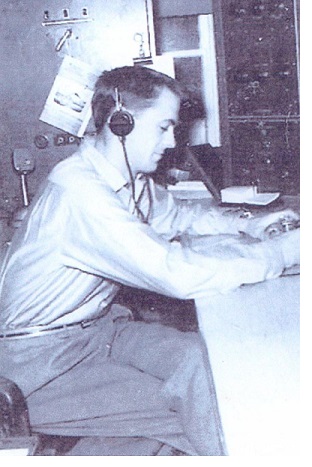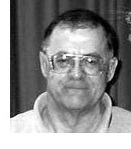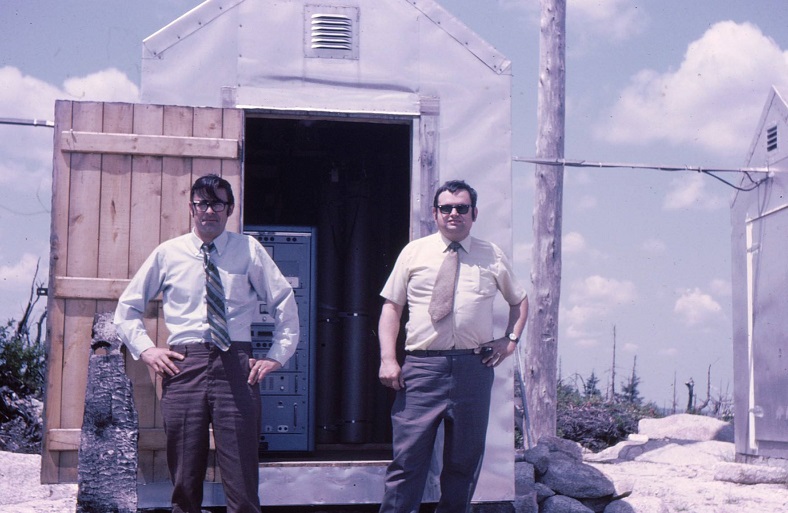(Scroll down to see photo on top of Cape Smokey)

 Lyle
received his second-class certificate of proficiency in radio at Saint John
Radio College graduating in 1956. The first person he can remember who was in
charge of the East Coast Marine Radio Service was out of Halifax and that
was H.H. MacLean who was Supt. of Marine
Radio Services. By early 1957 , the Marine-Aeradio were combined under regional
director Charlie Williams at Moncton.
Lyle
received his second-class certificate of proficiency in radio at Saint John
Radio College graduating in 1956. The first person he can remember who was in
charge of the East Coast Marine Radio Service was out of Halifax and that
was H.H. MacLean who was Supt. of Marine
Radio Services. By early 1957 , the Marine-Aeradio were combined under regional
director Charlie Williams at Moncton.
His first posting was at Moncton Aeradio for several months on the point to point CW
circuits. All the weather, aids to air navigation ,routine government messages
and requests for supplies from such places as Battle Harbour (VOH) and
Twillingate (VOO) Nfld. were handled on the morse circuits. Using frequencies
in the 4,5 and 6 Mhz range, Lyle recalls that after a few months he could copy
signals through roaring pandemonium (for the layman this translates to copying
usually weak signals through heavy static, atmospheric noises and other station
interference).
His
next posting, April 1957 was
Sable Island, call sign VGF, for eleven months and once again all
communications to and from the Island were on CW. His O.I.C. on Sable was
Gerry Smith, who was relieved by Johnny Weir in August 1957. Lyle was
transferred from VGF in the spring of 1958 after many adventures on that
Island of sand 180 miles south east of Halifax.
He
then spent several months at VBQ, Halifax Marine Radio Telephone and CW station
where a real old-timer Ray Bridger was in charge. Bridger was the only
person Lyle ever knew who saw the logs from Cape Race (VCE) where Ray had been
posted for several years. Ray could repeat almost word for word the contents
of the log of the night the Titanic went down in 1912.
Then after a brief tour of duty on the Sambro
Light Ship,
anchored 11.2 miles off Chebucto Head at the entrance to Halifax Harbour, he
was posted to Grindstone / VCN on the
Magdalen Islands where all were trapped by usually heavy ice every winter
from December to April. There was lots of ship traffic on MF, 440 and 500 Khz
and on Radio-telephone as well as maintaining skeds with seven lighthouses.
Even domestic telegrams were handled at VCN when the public teletype link was
down.
His O.I.C’s at VCN were Evert Kuhn, Keith Champion and Dewey Buck. During some 4 ½
years at VCN other operators with him were Terry Mackie, Jean Paul DesSaulnier,
Chester Turnbull, Doug Conrad, Ted Daley, Don Bishop.
Leaving VCN in Dec. 1962 Lyle then transferred to
VCS Halifax Marine
Radio with Jack Maher in charge and especially remembers supervisors Stan
Cairns, Don MacKay, Mike Mulcahey and many others. The Commonwealth radio
network had until the early 1960’s been operated by the Canadian Navy out of CFH (Albro Lake - Dartmouth) using both civilian and military radio operators,
handling a huge amount of commercial and military morse traffic. In 1963, VCS
took over the Commonwealth radio network, handling all commercial traffic. In
addition to medium frequencies 484 and 500 kHz, VCS was able to communicate
with ships all over the world on high frequencies in the 4,6,8 and 12 Mhz
ranges. Lyle can recall going on watch, handling so much commercial morse
traffic and distress communications that he ate his lunch on the way home after
his 8 hour shift.

Inspection of radio installations on top of
Cape Smokey, Cape Breton Island in 1971
Lyle Bates on the left and Hugh Little,
Marconi technician on the right
(Source: Jean Charles Lévesque, retired
technician, Marconi and CBC)
During the period 1957 - 1965 Lyle also served intermittent
periods as Radio Officer on the Canadian Hydrographic ships
Baffin, CGCL and
Kapuskasing CGCK. Later in 1965 he applied for and was accepted into the rank
of radio inspectors. He served many years as a radio inspector first at Sydney
N.S. from 1965 to 1974 and then Halifax from 1974 to retirement in 1989. During
those years he served for a time as manager of the Sydney office and then
later as senior inspector of the Halifax office.
Today he is happily retired with his wife Carole living at Middle Musquodoboit
N.S. and acts as net manager for a morse code social and traffic net on the
Amateur Radio 80, meter band where he can be often heard on 3654 kHz at 8 p.m.
local time. To him morse code is a language he can never forget.

